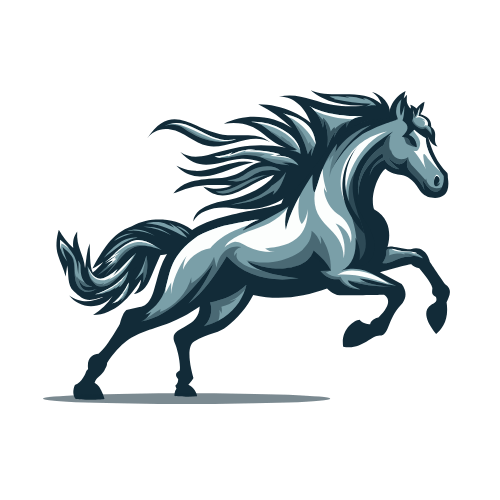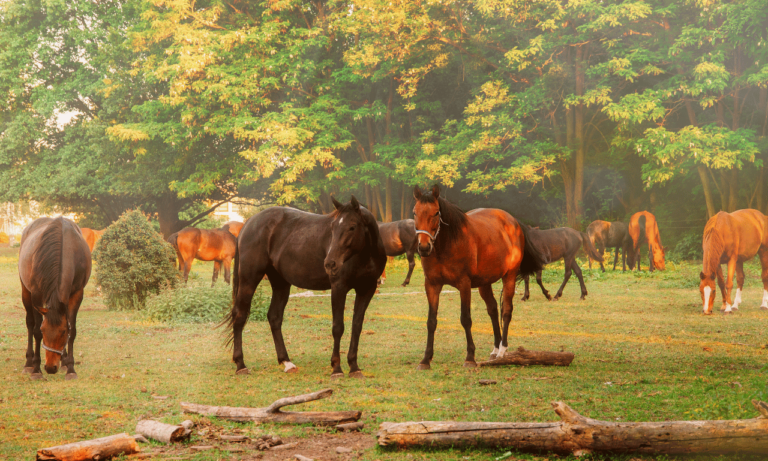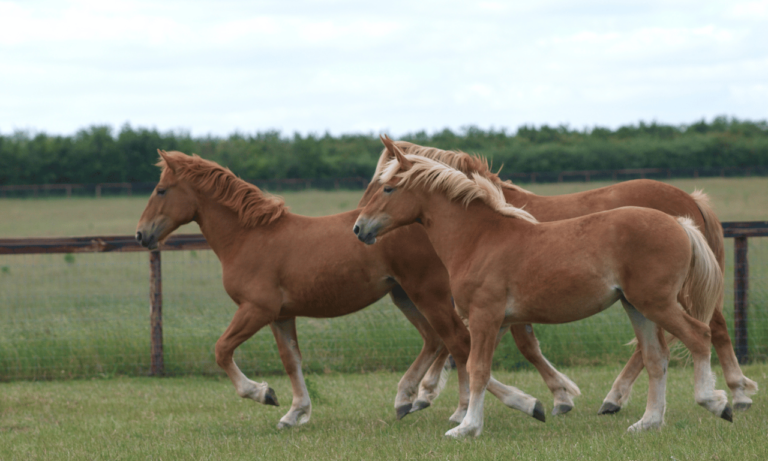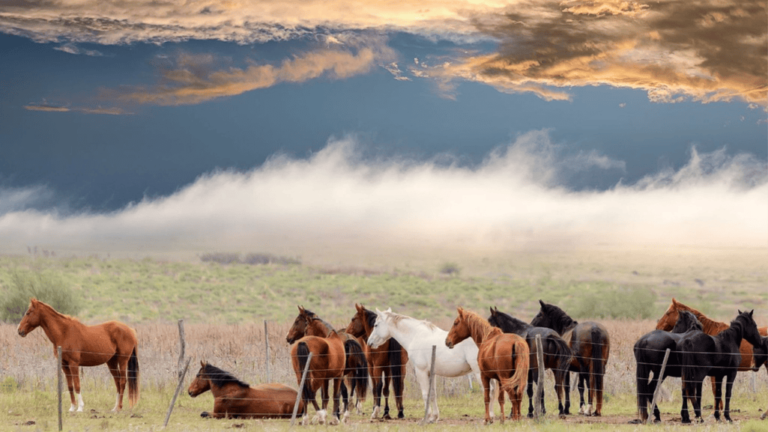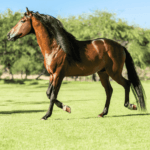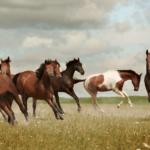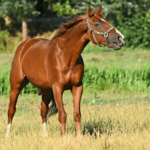The oldest horse in history has a story that goes back centuries. These animals have shaped our lands and history. They are part of our heritage, from strong farm horses to fast racetrack champions.
Historic videos show us the long journey of horses. They moved from farms to city streets, bringing elegance to urban life. Today, horses help us in many ways, showing their lasting impact on our lives.
Key Takeaways
- The showcased ancillary roles of horses pivotally shaped the historical tapestry of agriculture.
- Early 20th-century urban life was notably marked by the commonplace interweaving of horses amid city streets.
- Thoroughbred races illuminated the pinnacle of equine performance, symbolizing both speed and agility.
- A myriad of disciplines from showmanship to rodeo portray the versatile capabilities and adaptability inherent in horses.
- Horses sustain a contemporary importance through therapeutic riding and recreational pursuits, reinforcing their perpetual influence on human life.
A Journey Through Time: The Role of Horses in Human History
Looking into the historical horse lifespan and the growth of ancient horse records, it’s clear horses have deeply influenced human culture and progress. They’ve played key roles from farm work to urban life and sports. This shows the unique view of horse longevity history.
Horses started from small, fox-like creatures called Hyracotherium, living in North American grasslands about 55 million years ago. These early horses evolved into over 20 types due to different environments and challenges. This shows the early beginnings of historical equine longevity.
The domestication of horses, starting around 5,500 years ago in Kazakhstan, changed human-animal relationships. This partnership led to the creation of horse gear and the growth of horse populations worldwide. American Mustangs and Australian Brumbies became symbols of wild freedom and strength.
The bond between humans and horses has been about more than just utility. It’s about mutual respect and care, affecting historical horse lifespan. For example, Old Billy, the oldest recorded horse, lived to be 62 years old. This shows the potential for long life in horses with proper care.
| Horse Name | Lifespan | Notable Fact |
|---|---|---|
| Old Billy | 62 years | Known as the oldest recorded horse in history |
| Sugar Puff | 51 years | Highlighted the extended lifespan possible with good care |
| Billy | 38 years | Emphasized the impact of attentive care on horse longevity history |
Today, horses are important in therapy and sports, showing their ongoing value. As we learn and grow with horses, their history and our bond with them are key parts of our shared heritage. This bond has grown over thousands of years.
The Evolution of Horse Domestication in Early North America
Nicolas Delsol, from the Florida Museum of Natural History, found a domesticated horse’s tooth. This discovery is exciting and marks a big moment in the history of horses. It shows how horses were first domesticated in North America, changing how we see these animals in history.
Discovery of a Domesticated Horse’s Tooth
The tooth was found through DNA analysis. It’s the oldest known domesticated horse tooth in North America. This finding shows horses were domesticated early, changing what we thought about their arrival.
Domestication and the Transformation of Early American Societies
Horses changed North American societies a lot. They were brought by Europeans and became key to Native American life. They helped with travel, fighting, and trading, leading to big changes in how people lived.
Forging New Paths: The Colonial Introduction of Horses
The Spanish first brought horses back to the Americas, seeing their strength as an advantage. This move changed how people lived, farmed, and organized themselves. The story of horses coming on Spanish ships is different from the myths of shipwrecked horses. The arrival of horses had big effects on society across the continent.
| Epoch | Key Evolutionary Developments | Impact on Equine Features |
|---|---|---|
| Eocene | Appearance of early horse ancestors | Development from forest dwellers to grassland grazers |
| Oligocene | Transition from forests to grasslands | Adaptations to open habitats, increase in mobility |
| Miocene | Acceleration in evolutionary traits | Specialization in grazing, improved dental structures |
| Pliocene | Genus Equus evolves, closer to modern horses | Elongation of legs, changes in skull and tooth structure |
| Pleistocene | Spread across continents | Further diversification, adaptation to varied climates |
Unearthing the Oldest Horse in History: A Record-Breaking Fossil
A discovery in Canadian permafrost has changed our view of the ancient equine record. This find is more than a fossil; it’s the oldest DNA from a horse ever found. It gives us a deep look into the evolution of these magnificent animals.
The remains were from the Thistle Creek horse. Researchers sequenced its complete genome, over 700,000 years old. This beats the old record by a lot. It helps us understand the historical equine lifespan and their genetic history.
By comparing the Thistle Creek horse genome with modern horses and donkeys, scientists found a common ancestor. This ancestor lived about 4 million years ago. It shows how horses have adapted and survived for so long.
The fossil also adds to the study of evolution. It lets us see how horses have changed over time. Researchers found 73 ancient horse proteins in the Thistle Creek bone. This shows how life has changed over millions of years.
Exploring the DNA of the Thistle Creek horse reveals a lot of history. It satisfies scientific curiosity and shows respect for these animals. They have been important to humans for a long time.
In conclusion, finding the Thistle Creek horse fossil has changed how we see equine history. It’s a big step in understanding life on Earth. It connects the past, present, and future of horses.
Ancient Horse Fossils: Reconstructing a Prehistoric World
The study of ancient horse fossils has helped us understand the past. Researchers have recently sequenced the genome of a prehistoric horse. This is a big step in equine genome research.
The Groundbreaking Discovery in the Canadian Permafrost
In Yukon, scientists found a horse leg bone fragment. It had DNA over 700,000 years old. This discovery is the oldest DNA found so far, revealing much about the Ice Age.
Unlocking Genetic Mysteries: The Ancient Equine Genome
The DNA from these ancient horse fossils has opened new paths for scientists. It shows a wide range of genetic diversity. This suggests many ancestral species contributed to today’s horses.
Deducing the Ancestral Lineage of Modern Equines
Learning about the ancestral lineage of horses is important. It helps us understand science and wildlife. DNA studies show a complex history of horses, leading back 4 million years.
| Detail | Description | Approximate Timeline(Years Ago) |
|---|---|---|
| Origin of Equus | Emergence of the genus Equus, which includes modern horses, zebras, and donkeys. | 4,000,000 |
| Discovery of ancient genome | Discovery in Yukon, Canada, significant for being 10 times older than any previously identified ancient horse DNA. | 700,000 |
| Modern horse genome comparison | Comparison of the ancient genome with modern horses and Przewalski’s horse. | Ongoing research |
This work on ancient horse fossils is changing how we see history. By studying these fossils, scientists are learning about horse evolution. They are also uncovering more about life on Earth.
The Enduring Legacy of Equine Majestic Beauty
The history of humans and horses is filled with respect and admiration. Horses have been more than just animals; they’ve been companions and helpers. They’ve also been symbols of power and status.
These magnificent creatures have left a lasting impact on our culture. They are celebrated in art and continue to inspire awe and wonder.
Historical Perspectives on Equine Grace and Servitude
Horses have been admired for their beauty and strength throughout history. Ancient texts and artworks show their important role in shaping societies. They have been seen as heroes in battle and as vital in agriculture and transport.
Old film footage from the late 19th century highlights their diverse roles. It shows their strength and grace.
Horse Longevity and its Impact on Cultures Over Time
Horses have lived long lives, influencing many generations. They have played key roles in agriculture, transportation, and even in wars. Their ability to adapt and endure has set important milestones in their longevity.
The bond between humans and horses is deep and lasting. This connection is documented in historical records and films. Places like the National Archives and Records Administration (NARA) hold these stories.
In conclusion, horses are more than animals; they are vital partners in human history. Their beauty, strength, and historical significance are unmatched. Their portrayal in media over the years has helped us appreciate their roles and continues to inspire admiration for their beauty and longevity.
From Wild Steeds to Modern Breeds: Tracing Equine Evolution
The story of tracing equine evolution is filled with adaptation and change. Horses evolved from small, multi-toed animals to the strong, single-toed ones we know today. This journey through equine evolutionary history shows how these animals have changed over millions of years. They have become the diverse breeds that help us in many ways.
The journey from wild steeds to modern breeds is both fascinating and important. It helps us understand our past and present with horses. Domestication started around 4000 BCE, and by 3000 BCE, horses were a big part of human life. For more on early horse domestication, check out this detailed study.
Tracing the Family Tree: Ancient Equines to Modern Breeds
Today, we have over 300 horse breeds worldwide, each for different uses. Tracing equine evolution through genetics and fossils, like those in Germany’s Grube Messel mine, shows their big change. This shows how important horses are in our history.
Historical Significance of Horse Breeds in Human Advancement
Learning about historical horse breeds and their evolution shows their big role in human history. By studying their physical and genetic changes, we see how horses helped shape our world. Today, we have big draft horses, gentle ponies, and fast racing horses. They all show the lasting impact and ongoing change of this ancient line.
Looking at the journey from wild steeds to modern breeds, we see the genetic wealth of these animals. We also see how they’ve helped us in many ways for centuries.
Pioneering Research in Equine Longevity History
Groundbreaking studies in equine longevity research weave a complex picture of horse life spans. Historians and scientists work together to uncover the secrets of equine aging. This helps us understand how these magnificent animals have been with humans for centuries.
The “Warhorse: the archaeology of a medieval revolution?” project is a key example. It’s a joint effort between Smithsonian and the University of Exeter. This project explores the historical roles and survival of warhorses through archaeology and genetics.
In a recent episode of “Mad About Horses”, Dr. Chris Mortensen talked about the deep bond between horses and humans. He discussed how vet science has helped us understand horse longevity better. The story of Shayne, the world’s oldest horse, and his care at the Remus Memorial Horse Sanctuary show the progress in caring for aging horses.
| Period | Remains Found | Details |
|---|---|---|
| AD 1415-1450 to 1476-1636 | Horses’ remains (76) | Radiocarbon dating of bones, Late Medieval to Early Tudor periods |
| Modern Era | Isotope Analysis | Sampled 22 teeth from 15 horses; indicated varied geologies and hydration sources |
Mad Barn plays a big role in equine longevity research. They offer educational programs and engage with their community online. This work helps improve our understanding and care of horses, enhancing their quality of life.
Studying historic horse age analysis and equine aging records is crucial. It gives us insights into the climate and environment that shaped horses. Each piece of information adds to our understanding of horses’ history and their ongoing role in human society.
The Impact of Ancient Horses on Modern Equestrian Practices
The history of ancient equines has shaped today’s modern equestrian practices. From ancient military uses to today’s horseback riding clubs, their legacy is strong. This connection is seen in techniques, breeds, and the values of equestrian activities.
Records from the past show how horses have evolved. From warhorses to sports and pleasure rides, their journey is well-documented. Today’s breeding programs also rely on the genetic knowledge of these ancient horses.
| Historical Period | Key Equestrian Developments | Impacts on Modern Practices |
|---|---|---|
| Circa 3000 B.C. | Domestication and use in battle | Foundation for discipline-based training and breed development |
| 16th Century | Transition from cavalry to infantry in England | Adaptation in the training for agility over long-distance endurance |
| 16th Century + Early Modern Period | Rise of leisure activities and evolution of tack | Influence on sports like dressage and show jumping; improved tack and rider safety |
| 1600 | Recreational use becomes prominent | Shift towards non-military equestrian applications; enhancement of humane practices |
Studying the genetic history of horses through historical equestrian records is key. It helps modern breeding reflect the strength and qualities of ancient equines. The impact of ancient horses on modern equestrian practices is clear. It shows a heritage that spans thousands of years, inspiring and driving innovation in horseback riding.
How Ancient Equines Shaped Our Understanding of Horse Ages
The study of ancient horse lifespan has changed how we see horse ages. By looking at how Eohippus to Miohippus evolved, scientists learned a lot. They found out how changes in the environment affected these animals over time.
Looking into horse age history shows us how early horses were different from today’s. The first horses, like Hyracoterium, were much smaller. They grew bigger over time, thanks to evolution and breeding.
Domestication of horses started about 6,000 years ago, mainly above the Black Sea. This event changed horses a lot. It added new genes that affected their health and how long they lived.
| Epoch | Equine Species | Average Shoulder Height | Main Adaptations |
|---|---|---|---|
| Eocene | Hyracoterium | 30 – 40 cm | Arboreal Forest Dweller |
| Oligocene to Miocene | Mesohippus | Approximately 60 cm | Developed Springy Back, Better Suited for Running |
| Miocene | Merychippus | 100 cm | High-Crowned Teeth, Adapted to Grazing Grasses |
Studying ancient horse lifespan also helps us learn from modern Przewalski’s horses. They are wild but share a close link with Botai horses. This shows how breeding has changed horses over time, affecting their health and how well they adapt.
By digging deep into horse age history, we’ve learned a lot. This knowledge helps us take better care of domesticated horses. It keeps improving our understanding of horse ages.
Conclusion
Exploring equine lifespan history shows a journey through ages of horses and humans. It starts with Equus simplicidens around 4 million years ago. Then, horses were domesticated in Kazakhstan 5,500 years ago, changing human culture and progress.
The Spanish conquistadors brought European horses to North America. This marked the start of a lasting legacy. Horses became widespread, one of the most common mammals on Earth.
Now, the United States has the most horse breeds worldwide. We look back at key horse age milestones that shaped societies. Horses have played a big role in human history, from war to food and rituals.
The oldest living horse breeds, like the Akhal-Teke and Arabian, show their lasting nature. They are a testament to the bond between humans and horses.
As we reach the end of our journey on equine longevity, we understand more about horses. Selective breeding has changed their looks and their role in society. Their story is one of strength, friendship, and survival.
Today, research strengthens our connection with horses. It helps us appreciate their history and care for their future. This bond is crucial for their well-being and our shared future.
